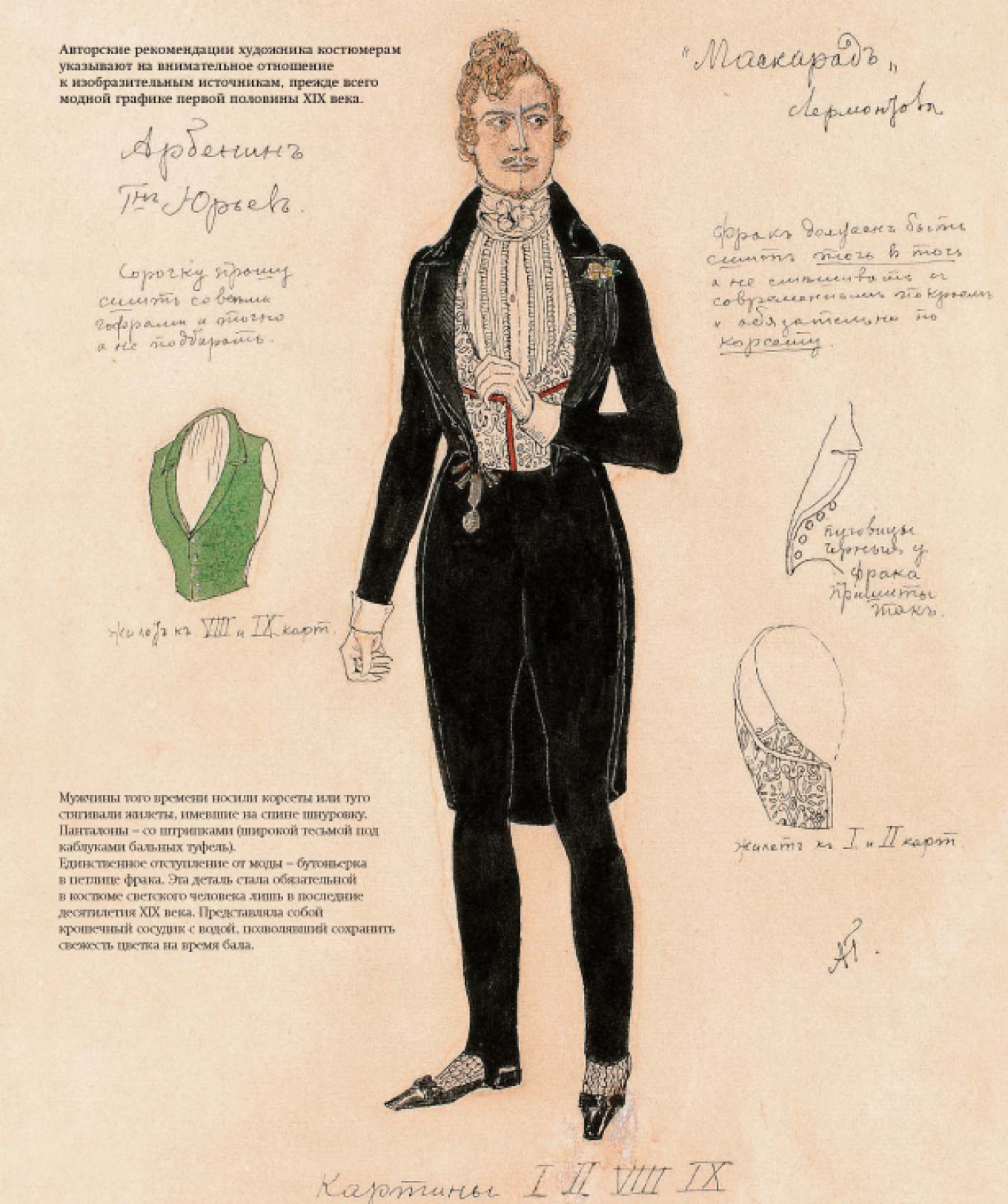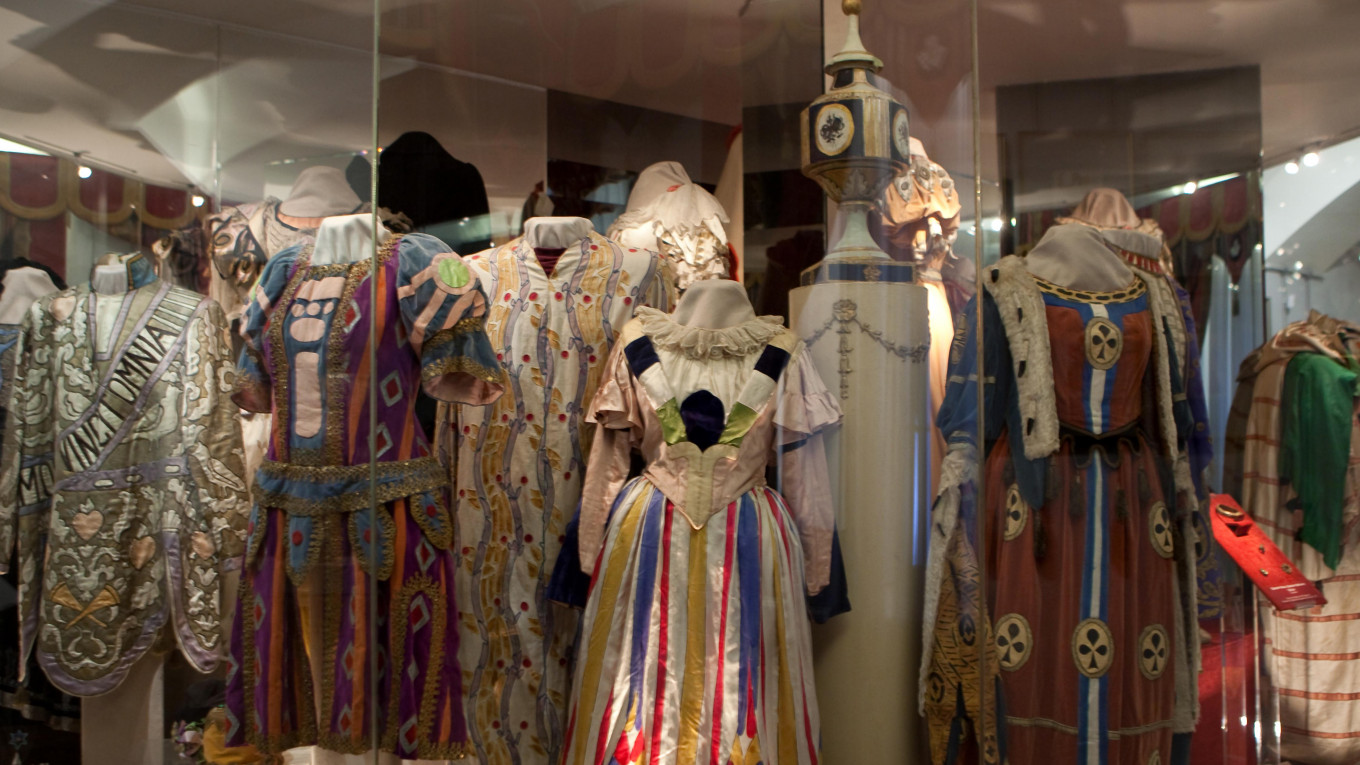On September 9 and 10, the Bolshoi Theater premieres Valery Fokin’s “Masquerade: Remembrance of the Future,” brought in from St. Petersburg’s Alexandrinsky Theater. The drama is being performed to celebrate the 100th anniversary of “Masquerade,” originally staged by Vsevolod Meyerhold, the pioneer of modern theater.
Meyerhold’s “Masquerade”
On February 25, 1917, the day of “Masquerade’s” premiere in the Alexandrinsky Theater, revolutionary bullets were already whistling on the streets of Petrograd. Yet the performance opened to a full house. The theater-going public was eager to see the show that had taken six years to mount and was the most expensive play ever staged in a Russian theater.
The grandiose performance, with a cast of nearly two hundred actors, unique scenery and superb costumes, was based on the classic drama by Mikhail Lermontov, Russia’s beloved 19th century writer. It is the story of Arbenin, a wealthy middle-aged aristocrat, who murders his young wife in a fit of jealousy and pride. During Lermontov’s lifetime, the show was banned as an offense to morals and had not been publicly performed before Meyerhold sparked new life into the play with his bold artistic vision. Meyerhold’s rediscovery of Lermontov was a key development in the modern Russian theater.
The political situation of 1917 gave Meyerhold’s “Masquerade” an apocalyptic touch. As Alexander Chepurov — theater critic, Rector and Professor of Russian State Institute of Performing Arts, and co-founder of the Museum of Russian Drama — told The Moscow Times, “Lermontov’s original text and Meyerhold’s interpretation of the drama were imbued with a sense of unease and a premonition of doom. This came from the romantic perception of life as a masquerade that concealed impending disaster. The image-structure of Meyerhold’s show was inspired by the idea that the end of humanity was nigh — a belief that dominated Lermontov’s times.”
“Masquerade” was completed in 1835. A year earlier Karl Bryullov’s “The Last Day of Pompeii” was shown to the public. The apocalyptic painting depicted a civilization brought to ruin for its sins. Many artistic images in Meyerhold’s play, including the curtain patterns, were reminiscent of Pompeii paintings and frescos. “The final scene ended with the fall of a mourning curtain that resembled ashes suddenly covering the magnificent scenery. Meyerhold’s contemporaries said that this was the mourning curtain for the Russian Empire. The pessimists were right. “Masquerade” was the last theater premiere in tsarist Russia. February of 1917 was, in many ways, the end of Russian civilization,” Chepurov said.
Famous for his unorthodox interpretations of classics, Meyerhold nevertheless treated Lermontov’s drama with respect. The director kept the structure of the original play but added elements of dance. Lermontov’s romanticism was a good fit for the general artistic style of the Alexandrinsky Theater, known for lavish decorations, refined stage sceneries and romantic declamatory rhetoric.

Golovin’s Designs
The Russian artist Alexander Golovin was the chief designer who created the stunning scenery, approximately three hundred costumes, over one hundred pieces of furniture and eight stage curtains. Golovin made over four thousand sketches detailing every object on stage. His goal was to create a perfect aesthetic stage that was both accurate in historical details, yet flexible in historical authenticity. For example, furniture pieces were created larger than their original sizes so that they could be seen even from the back rows of the hall.

Saved Against All Odds
Meyerhold’s “Masquerade” is considered to be the most mysterious of all Russian dramas. Miraculously, almost all “Masquerade’s” costumes, along with some sets and furniture, survived the turbulent 20th century and can now be seen on the top floors of the Alexandrinsky Theater in the Museum of Russian Drama. “Masquerade’s” curtains have even been displayed on stage for special events. And the production ran for almost twenty-five years, even after 1940 when Meyerhold was labeled an enemy of the people and imprisoned, and his name was removed from the theatrical credits. Leonid Vivyen, Alexandrinsky’s Theater director, and Yuri Yuryev, the leading actor who played Arbenin, managed to keep the show running. The last version of the play was released under Yuryev’s name, whose status as People’s Artist of the U.S.S.R. saved the show from censorship.
During a bombing raid in the beginning of autumn 1941, an incendiary bomb damaged the theater's warehouse where the "Masquerade" sets were kept. For many years, it was thought that the decorations had been destroyed. But this was just the official version promoted by the Soviet authorities, a convenient explanation of why the show was no longer performed. In reality, only a few pieces were destroyed during the fire and the rest were safely preserved. Shortly after the war, after receiving a report about the condition of the play’s props, Leonid Vivyen issued his now legendary resolution: “Preserve forever.”
“The general public believed that “Masquerade’s” legacy was gone forever. Only after Meyerhold’s rehabilitation in 1955 did the Alexandrinsky Theater announce that many of the items survived: parts of the stage decorations, curtains, costumes, and pieces of furniture. In 1974, during the celebration of Meyerhold’s 100th anniversary, the famous “Masquerade” curtain was solemnly unveiled on the same stage. “People who had been lucky enough to see the original show wept,” Chepurov said.
New Life for an Old Masterpiece
For a century, the myths and ghosts of “Masquerade” have lived in the walls of the Alexandrinsky Theater. But it was Valery Fokin, director of the theater and the current president of the Meyerhold center in Moscow, who first came up with the idea of reviving Meyerhold’s show. Chepurov said that, “It was obvious that Meyerhold’s complex performance couldn’t be repeated. Fokin wasn’t sure if the mystic images of ‘Masquerade’ could be recreated and make sense in the modern context. So several years ago, before the 200th anniversary of Lermontov’s birth, Fokin suggested a reincarnation of the show – a new performance which would suggest Meyerhold’s images and be in dialogue with that iconic artistic work.”
Fokin’s show “Remembrance of the Future” will have its premiere in Moscow in September. It opens with a ghostly scene: Golovin’s masquerade costumes step out of glass cases and prance about the stage, as if the theater’s museum is coming to life. It is an image both mystical and enchanting. The show is accompanied by audio recordings of Meyerhold’s “Masquerade,” vintage photographs and footage. Careful research of archive documents was undertaken by Fokin and his team in order to recreate the scenery of the performance, the light and sound —the whole atmosphere of the period. Yuri Yuryev’s notes on the Arbenin’s lines helped the actors to recreate the original “music” of Meyerhold’s dialogues with the right intonation and pauses.
Fokin has created a new detailed director’s script. New music was developed by composer Alexander Bakshi, who used the supporting music of the original audio recording written by the acclaimed musician Alexander Glazunov. Old pictures of “Masquerade” actors helped ballet-master Igor Kachayev to recreate the play’s choreography. Set designer Semyon Pastukh used Golovin’s images and sketches as the basis for his new designs.
Fokin’s “Remembrance of the Future” is a dialogue between Meyerhold and Lermontov, between the past and the future. “Fokin suggests that we turn to the past to foresee the times ahead. Lermontov felt pain for the distortion of human ideals, by the masquerade of illusory passions, when real human faces are hidden behind cold masks. He felt that a world with no truth and sincerity could not continue to exist,” says Chepurov. “This became a prophetic metaphor for Meyerhold’s play — a masquerade of an entire historical era. Today when tensions are high and the world is seeking redemption, we feel that Lermontov’s ideas are as relevant as ever.”
A Message from The Moscow Times:
Dear readers,
We are facing unprecedented challenges. Russia's Prosecutor General's Office has designated The Moscow Times as an "undesirable" organization, criminalizing our work and putting our staff at risk of prosecution. This follows our earlier unjust labeling as a "foreign agent."
These actions are direct attempts to silence independent journalism in Russia. The authorities claim our work "discredits the decisions of the Russian leadership." We see things differently: we strive to provide accurate, unbiased reporting on Russia.
We, the journalists of The Moscow Times, refuse to be silenced. But to continue our work, we need your help.
Your support, no matter how small, makes a world of difference. If you can, please support us monthly starting from just $2. It's quick to set up, and every contribution makes a significant impact.
By supporting The Moscow Times, you're defending open, independent journalism in the face of repression. Thank you for standing with us.
Remind me later.






